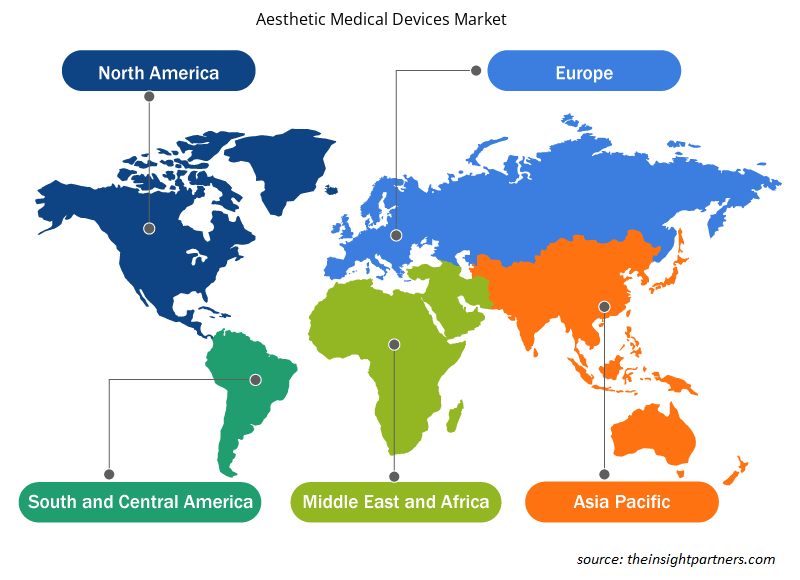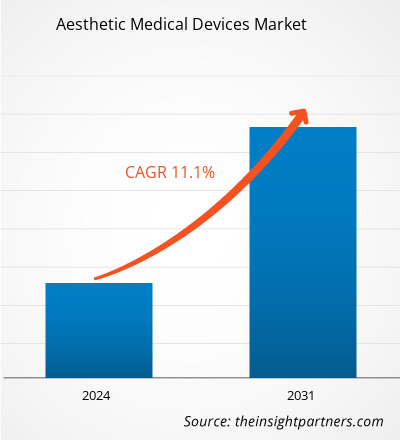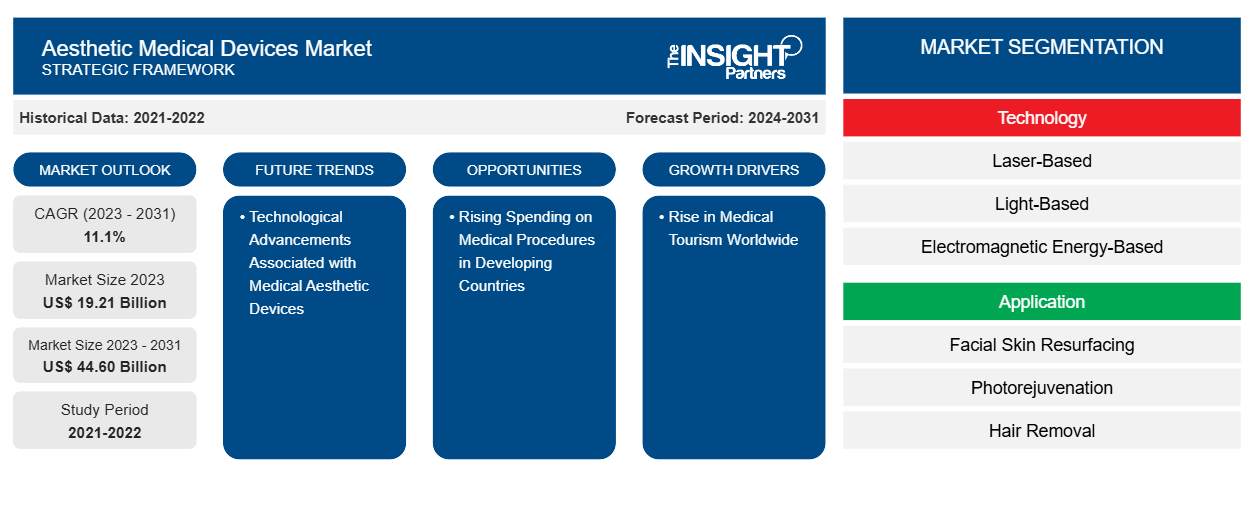Der Markt für ästhetische Medizinprodukte soll von 19,21 Milliarden US-Dollar im Jahr 2023 auf 44,60 Milliarden US-Dollar im Jahr 2031 anwachsen. Der Markt soll zwischen 2023 und 2031 eine durchschnittliche jährliche Wachstumsrate (CAGR) von 11,1 % verzeichnen. Ein steigender Bedarf an organischen und natürlichen Aknebehandlungen dürfte weiterhin ein wichtiger Markttrend für ästhetische Medizinprodukte bleiben.
Marktanalyse für ästhetische Medizinprodukte
Der weltweite Anstieg des Medizintourismus, die Zunahme von Hautkrankheiten und das Bewusstsein der Verbraucher für Hautpflegebehandlungen, die zunehmende Anwendung minimalinvasiver und nichtinvasiver ästhetischer Verfahren, die steigenden Ausgaben für medizinische Verfahren in Entwicklungsländern und die Markteinführung und Zulassung neuer Produkte sowie der technologische Fortschritt im Bereich medizinisch-ästhetischer Geräte sind nur einige Faktoren, die das Marktwachstum beeinflussen. Die Hersteller entwickeln benutzerfreundliche Geräte, um ihren Kundenstamm zu erweitern. Darüber hinaus arbeiten die Hersteller mit Schönheitskliniken zusammen, um ihre Präsenz auf dem Markt auszubauen.
Marktübersicht für ästhetische Medizinprodukte
Ästhetische Geräte werden von der FDA auf Grundlage ihres Verwendungszwecks und ihrer Auswirkungen auf die Struktur oder Funktion des Körpers kontrolliert. Die weltweite Verfügbarkeit innovativer und faszinierender ästhetischer medizinischer Geräte hat in den letzten Jahren zu einem Anstieg der Nachfrage nach medizinisch-ästhetischen Behandlungen geführt. Ästhetische medizinische Geräte basieren auf Technologien wie der Radiofrequenztechnologie (die am weitesten verbreitete und äußerst vorteilhafte Technologie zur Reduzierung von Gesichtsfalten), Ultraschalltechnologie, Lasertechnologie usw. Die Weiterentwicklung hochtechnologischer ästhetischer medizinischer Geräte macht kosmetische Behandlungen effektiver und sicherer und schafft eine starke Nachfrage nach Ärzten, Kosmetikern, Kosmetologen und anderen Hautpflegespezialisten.
Passen Sie diesen Bericht Ihren Anforderungen an
Sie erhalten kostenlos individuelle Anpassungen an jedem Bericht, einschließlich Teilen dieses Berichts oder einer Analyse auf Länderebene, eines Excel-Datenpakets sowie tolle Angebote und Rabatte für Start-ups und Universitäten.
- Holen Sie sich die wichtigsten Markttrends aus diesem Bericht.Dieses KOSTENLOSE Beispiel umfasst eine Datenanalyse von Markttrends bis hin zu Schätzungen und Prognosen.
Markttreiber und Chancen für ästhetische Medizinprodukte
Anstieg der Einführung minimalinvasiver und nichtinvasiver ästhetischer Verfahren begünstigt den Markt
Minimalinvasive Eingriffe bieten Patienten verschiedene Vorteile, darunter kürzere Ausfallzeiten, weniger Narbenbildung, geringere Risiken, begrenzten Stress, höhere Patientenzufriedenheit und schnellere Genesungszeiten im Vergleich zu herkömmlichen invasiven Operationen. Dieser Trend hin zu minimalinvasiven Ansätzen wird durch mehrere Faktoren vorangetrieben, wie etwa technologische Fortschritte bei ästhetischen Geräten, eine zunehmende Präferenz der Patienten für nicht-chirurgische Optionen und Fortschritte in der medizinischen Forschung und Technik. Darüber hinaus geht der Anstieg minimalinvasiver Eingriffe mit einem breiteren gesellschaftlichen Wandel hin zu Wellness, natürlich aussehenden Verbesserungen und personalisierten Behandlungsansätzen einher. Patienten, die ästhetische Behandlungen suchen, werden oft von minimalinvasiven Optionen angezogen, die subtile Verbesserungen und sichtbare Ergebnisse bieten, ohne dass umfangreiche chirurgische Eingriffe erforderlich sind. Laut der American Society of Plastic Surgeons wurden im Jahr 2022 in den USA 26,2 Millionen chirurgische und minimalinvasive kosmetische Eingriffe durchgeführt. Außerdem sind die kosmetischen Operationen im Vergleich zu 2019 um 19 % gestiegen. Der Anstieg der Einführung minimalinvasiver und nichtinvasiver ästhetischer Eingriffe treibt also das Wachstum des Marktes für ästhetische Medizin voran.
Steigende Ausgaben für medizinische Behandlungen in Entwicklungsländern
Die rasante Urbanisierung, die steigenden Investitionen der Gesundheitsdienstleister in die Verbesserung der Infrastruktur, das wachsende Bewusstsein der Bevölkerung und die Verfügbarkeit einer breiten Palette fortschrittlicher Produkte und Technologien in Entwicklungsländern haben dazu beigetragen, diese zu Zentren des Medizintourismus zu machen. In Saudi-Arabien, Russland, Brasilien, Indien und Südafrika konzentrieren sich die Gesundheitssysteme auf die Einführung verschiedener fortschrittlicher medizinisch-ästhetischer Technologien in ihr Dienstleistungsportfolio. Patienten aus entwickelten Regionen reisen für verschiedene medizinisch-ästhetische Eingriffe in Schwellenländer. Gesundheitseinrichtungen, medizinische Spas und Wellnesscenter bieten zunehmend ein umfassendes Angebot kostengünstiger, aber qualitativ hochwertiger medizinisch-ästhetischer Eingriffe an. Die Ausgaben für kosmetische und Verjüngungsoperationen zur Verbesserung der Ästhetik steigen in der Weltbevölkerung rasant an. In Entwicklungsländern steigt das Bewusstsein für minimalinvasive Behandlungen und die Akzeptanz ästhetischer Eingriffe in der Bevölkerung, das Bedürfnis nach einem idealen körperlichen Erscheinungsbild wächst, die Häufigkeit von Hautkrankheiten nimmt zu, die geriatrische Bevölkerung wächst und die Verfügbarkeit und Akzeptanz technologisch fortschrittlicher medizinischer Geräte steigt. Außerdem ermöglichen die steigenden Gesundheitsausgaben in Entwicklungsländern im asiatisch-pazifischen Raum den Angehörigen medizinischer Berufe, fortschrittliche Technologien für kosmetische Eingriffe einzusetzen. Daher wird erwartet, dass die steigenden Ausgaben für medizinische Eingriffe in Entwicklungsländern im Prognosezeitraum Wachstumschancen für den Markt für ästhetische medizinische Geräte schaffen werden.
Segmentierungsanalyse des Marktberichts für ästhetische Medizingeräte
Wichtige Segmente, die zur Ableitung der Marktanalyse für ästhetische Medizingeräte beigetragen haben, sind Technologie, Anwendung und Endbenutzer.
- Basierend auf der Technologie ist der Markt für ästhetische Medizingeräte in laserbasierte, lichtbasierte, elektromagnetische Energie-basierte, ultraschallbasierte, Kryolipolyse-basierte, saugbasierte, plasmaenergiebasierte, EMS-basierte und Mikrowellengeräte unterteilt. Das laserbasierte Segment hatte 2023 den größten Marktanteil.cryolipolysis, suction-based, plasma energy-based, EMS, and microwave. The laser-based segment held the largest market share in 2023.
- Nach Anwendung ist der Markt in Akne und Aknenarben, Haarentfernung, Gesichtshauterneuerung, Photorejuvenation, Hautstraffung, weibliche Verjüngung, Fettabbau und Körperkonturierung, Tätowierungen und Pigmentierung, Gefäßläsionen, Cellulite-Reduktion und andere unterteilt. Das Segment Akne und Aknenarben hatte 2023 den größten Marktanteil.photorejuvenation, skin tightening, feminine rejuvenation, fat reduction and body contouring, tattoos and pigmentation, vascular lesions, cellulite reduction, and others. The acne and acne scars segment held the largest share of the market in 2023.
- In Bezug auf den Endverbraucher wird der Markt in Dermatologie- und Kosmetikkliniken, Krankenhäuser und Kliniken, medizinische Spas und Heimgebrauch unterteilt. Das Segment Dermatologie- und Kosmetikkliniken dominierte den Markt im Jahr 2023.
Marktanteilsanalyse für ästhetische Medizingeräte nach Geografie
Der geografische Umfang des Marktberichts für ästhetische Medizingeräte ist hauptsächlich in fünf Regionen unterteilt: Nordamerika, Asien-Pazifik, Europa, Naher Osten und Afrika sowie Süd- und Mittelamerika.
Nordamerika dominiert den Markt für ästhetische Medizinprodukte. Die USA hatten 2023 den größten Marktanteil, was auf die gestiegene Zahl ästhetischer Eingriffe zurückzuführen ist. Außerdem haben technologische Entwicklungen die Zahl minimalinvasiver und nichtinvasiver Eingriffe im Land erhöht. Laut der American Society of Plastic Surgeons wurden 2022 in den USA 26,2 Millionen chirurgische und minimalinvasive Operationen durchgeführt. Darüber hinaus wurden laut ASAPS 2020 im Jahr 2020 15,6 Millionen kosmetische Eingriffe verzeichnet, darunter etwa 2,3 Millionen kosmetische chirurgische und 13,2 Millionen kosmetische minimalinvasive Eingriffe. Die Behandlung mit intensivem gepulstem Licht (IPL) gehört zu den fünf häufigsten kosmetischen minimalinvasiven Eingriffen. Im Jahr 2020 wurden im Land über 827.000 IPL-Eingriffe durchgeführt. Der asiatisch-pazifische Raum wird in den kommenden Jahren voraussichtlich die höchste durchschnittliche jährliche Wachstumsrate auf dem Markt verzeichnen.
Regionale Einblicke in den Markt für ästhetische Medizingeräte
Die regionalen Trends und Faktoren, die den Markt für ästhetische Medizinprodukte während des Prognosezeitraums beeinflussen, wurden von den Analysten von Insight Partners ausführlich erläutert. In diesem Abschnitt werden auch die Marktsegmente und die Geografie für ästhetische Medizinprodukte in Nordamerika, Europa, im asiatisch-pazifischen Raum, im Nahen Osten und Afrika sowie in Süd- und Mittelamerika erörtert.

- Erhalten Sie regionale Daten zum Markt für ästhetische Medizinprodukte
Umfang des Marktberichts über ästhetische Medizinprodukte
| Berichtsattribut | Details |
|---|---|
| Marktgröße im Jahr 2023 | 19,21 Milliarden US-Dollar |
| Marktgröße bis 2031 | 44,60 Milliarden US-Dollar |
| Globale CAGR (2023 - 2031) | 11,1 % |
| Historische Daten | 2021-2022 |
| Prognosezeitraum | 2024–2031 |
| Abgedeckte Segmente | Nach Technologie
|
| Abgedeckte Regionen und Länder | Nordamerika
|
| Marktführer und wichtige Unternehmensprofile |
|
Marktteilnehmerdichte für ästhetische Medizinprodukte: Auswirkungen auf die Geschäftsdynamik verstehen
Der Markt für ästhetische Medizinprodukte wächst rasant, angetrieben durch die steigende Nachfrage der Endnutzer aufgrund von Faktoren wie sich entwickelnden Verbraucherpräferenzen, technologischen Fortschritten und einem größeren Bewusstsein für die Vorteile des Produkts. Mit steigender Nachfrage erweitern Unternehmen ihr Angebot, entwickeln Innovationen, um die Bedürfnisse der Verbraucher zu erfüllen, und nutzen neue Trends, was das Marktwachstum weiter ankurbelt.
Die Marktteilnehmerdichte bezieht sich auf die Verteilung der Firmen oder Unternehmen, die in einem bestimmten Markt oder einer bestimmten Branche tätig sind. Sie gibt an, wie viele Wettbewerber (Marktteilnehmer) in einem bestimmten Marktraum im Verhältnis zu seiner Größe oder seinem gesamten Marktwert präsent sind.
Die wichtigsten auf dem Markt für ästhetische Medizinprodukte tätigen Unternehmen sind:
- Alma Lasers
- Merz Pharma GmbH Co KGaA
- Bausch Health Companies Inc
- Lumenis Be Ltd
- Venus Concept Inc
- Cutera Inc
Haftungsausschluss : Die oben aufgeführten Unternehmen sind nicht in einer bestimmten Reihenfolge aufgeführt.

- Überblick über die wichtigsten Akteure auf dem Markt für ästhetische Medizinprodukte
Marktnachrichten und aktuelle Entwicklungen für ästhetische Medizinprodukte
Der Markt für ästhetische Medizinprodukte wird durch die Erhebung qualitativer und quantitativer Daten nach Primär- und Sekundärforschung bewertet, die wichtige Unternehmensveröffentlichungen, Verbandsdaten und Datenbanken umfasst. Im Folgenden finden Sie eine Liste der Entwicklungen auf dem Markt für ästhetische Medizinprodukte und Strategien:
- Bausch Health Companies Inc. und Solta Medical, ein weltweit führendes Unternehmen auf dem Markt für medizinische Ästhetik, gaben die Zulassung von Thermage FLX und des TR-4 Return Pad durch die chinesische National Medical Products Administration (NMPA) bekannt. Das TR-4 Return Pad wurde außerdem von der US-amerikanischen Food & Drug Administration (im Rahmen der Geräteregistrierung von Thermage FLX) zur Verwendung zugelassen.
(Quelle: Bausch Health Companies Inc, Pressemitteilung, 2024)
- CUTERA, INC., ein führender Anbieter von ästhetischen und dermatologischen Lösungen, gab die international begrenzte kommerzielle Markteinführung von AviClear bekannt, dem ersten energiebasierten Gerät mit FDA-Zulassung für die Langzeitbehandlung von leichter, mittelschwerer und schwerer Akne.
(Quelle: Cutera Inc, Pressemitteilung, 2024)
- Venus Concept Inc., ein weltweit führendes Unternehmen im Bereich der medizinischen Ästhetiktechnologie, hat die Markteinführung seiner neuen Multi-Anwendungsplattform Venus Versa Pro in den USA angekündigt. Venus Versa Pro unterstützt 10 verschiedene Applikatoren, die einzeln oder in Kombination verwendet werden können, um eine breite Palette ästhetischer Probleme zu behandeln, darunter Hautstruktur, Akne vulgaris, vaskuläre und pigmentierte Läsionen, Gesichtsfalten usw.
(Quelle: Venus Concept Inc., Pressemitteilung, 2023)
- Lumenis Ltd., das weltweit größte Unternehmen für energiebasierte Medizinprodukte für ästhetische, chirurgische und ophthalmische Anwendungen, gab eine neue Partnerschaft mit der renommierten Harrods Wellness Clinic in London, Großbritannien, bekannt. Harrods wird seine Schönheitsklinik mit dem Stellar M22 ausstatten. (Quelle: Lumenis Be Ltd, Pressemitteilung, 2021)
Marktbericht zu ästhetischen Medizinprodukten – Umfang und Ergebnisse
Der Bericht „Marktgröße und Prognose für ästhetische Medizingeräte (2021–2031)“ bietet eine detaillierte Analyse des Marktes, die die folgenden Bereiche abdeckt:
- Marktgröße und Prognose auf globaler, regionaler und Länderebene für alle wichtigen Marktsegmente, die im Rahmen des Projekts abgedeckt sind
- Marktdynamik wie Treiber, Beschränkungen und wichtige Chancen
- Wichtige Zukunftstrends
- Detaillierte PEST/Porters Five Forces- und SWOT-Analyse
- Globale und regionale Marktanalyse mit wichtigen Markttrends, wichtigen Akteuren, Vorschriften und aktuellen Marktentwicklungen
- Branchenlandschaft und Wettbewerbsanalyse, einschließlich Marktkonzentration, Heatmap-Analyse, prominenten Akteuren und aktuellen Entwicklungen
- Detaillierte Firmenprofile
- Historische Analyse (2 Jahre), Basisjahr, Prognose (7 Jahre) mit CAGR
- PEST- und SWOT-Analyse
- Marktgröße Wert/Volumen – Global, Regional, Land
- Branchen- und Wettbewerbslandschaft
- Excel-Datensatz
Aktuelle Berichte
Verwandte Berichte
Erfahrungsberichte
Grund zum Kauf
- Fundierte Entscheidungsfindung
- Marktdynamik verstehen
- Wettbewerbsanalyse
- Kundeneinblicke
- Marktprognosen
- Risikominimierung
- Strategische Planung
- Investitionsbegründung
- Identifizierung neuer Märkte
- Verbesserung von Marketingstrategien
- Steigerung der Betriebseffizienz
- Anpassung an regulatorische Trends





















 Kostenlose Probe anfordern für - Markt für ästhetische Medizinprodukte
Kostenlose Probe anfordern für - Markt für ästhetische Medizinprodukte